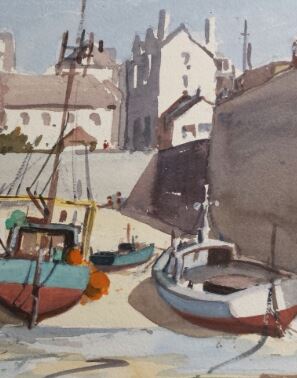What is “giclee”?
This was - initially - a way of making fine art prints from a digital source on ink-jet printers in the early 1990’s. More commonly used now to denote any high quality inkjet-based digital art print, and is commonly found in all good print shops and galleries to enable a buyer to obtain a high quality print at a realistic price.
The word is actually derived from the french “le gicleur” which means a nozzle and the phrase “gicler” meaning to spray i.e. the action of an inkjet printer.
What is “gouache”?
This is essentially a “heavier” paint than watercolour. It is still pigment suspended in water but with larger particles, a higher ratio of pigment to water is present, and a white pigment or “body colour” (often chalk) is
added. This has the effect of making the paint heavier /thicker looking, gives a heavier opaque finish, and to many people, offers a great quality of painting and a longer life for the work. It is often used to highlight
watercolours with some definition, and long ago the technique was used to illuminate manuscripts with brightly pigmented colours.
This was - initially - a way of making fine art prints from a digital source on ink-jet printers in the early 1990’s. More commonly used now to denote any high quality inkjet-based digital art print, and is commonly found in all good print shops and galleries to enable a buyer to obtain a high quality print at a realistic price.
The word is actually derived from the french “le gicleur” which means a nozzle and the phrase “gicler” meaning to spray i.e. the action of an inkjet printer.
What is “gouache”?
This is essentially a “heavier” paint than watercolour. It is still pigment suspended in water but with larger particles, a higher ratio of pigment to water is present, and a white pigment or “body colour” (often chalk) is
added. This has the effect of making the paint heavier /thicker looking, gives a heavier opaque finish, and to many people, offers a great quality of painting and a longer life for the work. It is often used to highlight
watercolours with some definition, and long ago the technique was used to illuminate manuscripts with brightly pigmented colours.
The term “gouache” is often used to describe any work using opaque or matt paints.
What is a “lithograph” or “chromolithograph”?
This is a widely used term to denote, essentially, an authorised copy of an artist’s work, usually created by the artist, or its production is monitored by the artist (as opposed to a “reproduction” which is simply created many times over, often these days without the artist’s permission, using photomechanical or photoelectronic methods).
A relatively short print run i.e. lithographs kept to just 300 or 500 copies or so, help to maintain a good value on each copy.
Modern printing means many paintings are produced in the thousands or millions and are worth nothing, but a genuine numbered lithograph is still prized by collectors.
The lithographer draws a mirrored image of the original artwork onto stone using a grease-based crayon (or a greasy ink called “tusche”). Once the artist is happy with the quality of the image it starts to be turned into a lithograph. An oil-based ink is applied directly to the plate which bonds with oily medium used to draw the copy and water is applied to the unpainted areas to ensure the ink does not travel across the work.
A sheet of high quality cotton-based paper is placed over the plate. The inked stone or metal plate with the paper are put in a press and pressure is used to transfer the ink. If the original was a simple pen and ink drawing, this would be the only press needed, but a coloured lithograph will need several presses with coloured inks.
A chromolithograph is, pretty simply, a coloured lithograph..produced using a separate stone for each colour, popular from the mid to the late 1800’s, when better methods started to be discovered.
What is an “etching” or “engraving”?
Etchings are produced by using an acid-resistant layer of wax on a metal plate. The drawing is “etched” into that wax using an etching needle. Once the plate is dipped into acid..the acid works on the exposed drawing lines and so etches the design onto the plate. If some darker lines are needed in the drawing, then sections of the plate can be “stopped out” with a varnish solution so when the whole plate is dipped into acid again the darker lines are created where the design has not been “stopped out”.
An engraving is drawn onto a metal plate using a sharp tool called a graver or a “burin”, using sheer pressure to create the image lines. Powdered rosin is used to create the tones of colour. So - essentially - engravings are achieved by removing metal with metal, etchings by removing metal with acid.
A DRYPOINT etching is usually done on softer copper plate, and when the plate is incised it has a raised rough edge to the lines (“burr”) - and both the lines AND the burr are inked when the plate is wiped so the resulting print looks very delicate and fine. The print run from the plate is small as the
repeated pressing crushes the burr.
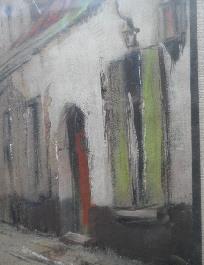
Example of gouache, with thicker body-coloured paint used on top of watercolour
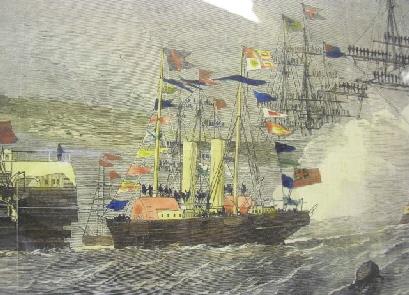
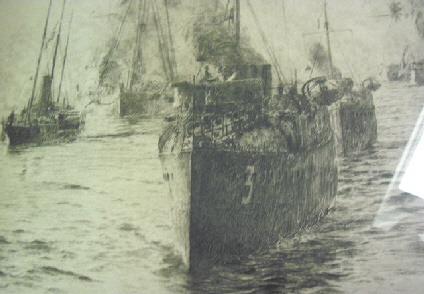
Example of an engraving - usually defined hard lines (some expert engravers did manage to produce “softer” work, however). This example has been hand coloured.
Example of an etching (this one is actually a drypoint etching) - this method produces much softer images
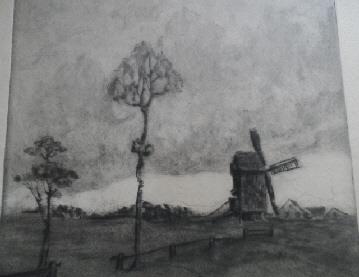
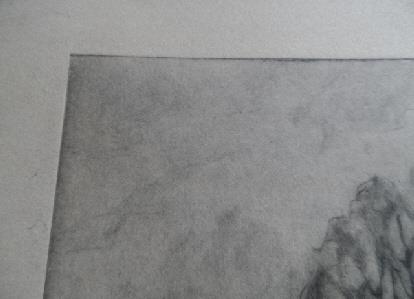
Example of an etching
Indented platemarks
What is an “oleograph”’?
This a lithograph / chromolithograph made to look like an oil painting, with the addition of textured oil paint, Often printed onto canvas instead of paper.
What is an “aquatint”?
Essentially, a print using a technique which makes it appear like a watercolour, the process adds tone and shadow. Produced using a zinc or copper plate which can hold ink, to transfer an image to paper. Acid is used to etch the image on the plate, and powdered rosin is used to create the tones of colour. The etching time is varied to produce light or deep tones.
This a lithograph / chromolithograph made to look like an oil painting, with the addition of textured oil paint, Often printed onto canvas instead of paper.
What is an “aquatint”?
Essentially, a print using a technique which makes it appear like a watercolour, the process adds tone and shadow. Produced using a zinc or copper plate which can hold ink, to transfer an image to paper. Acid is used to etch the image on the plate, and powdered rosin is used to create the tones of colour. The etching time is varied to produce light or deep tones.
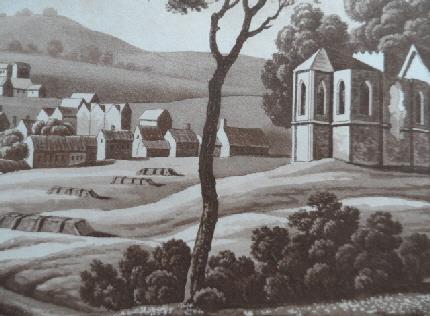
Example of an aquatint
What is a “crystoleum”?
This was a technique used for a relatively short time, around 1875 until about 1915 (coinciding with a WW1 effect on materials availability). Essentially, a photograph is soaked with an agent which “fixes” the image to a piece of (usually slightly convex) glass, this can take several days and is fairly complex. The image can then be “painted”...and paint is applied to the inside of the piece of glass and a second piece of glass which fits snugly against the first is also painted with slightly thicker paint to emphasise the image on the first glass.
This is a VERY brief description of the process, but the end result was a very highly coloured piece of art on glass which could then be framed. The aim was to replicate the fine painting and colours achieved on porcelain
This was a technique used for a relatively short time, around 1875 until about 1915 (coinciding with a WW1 effect on materials availability). Essentially, a photograph is soaked with an agent which “fixes” the image to a piece of (usually slightly convex) glass, this can take several days and is fairly complex. The image can then be “painted”...and paint is applied to the inside of the piece of glass and a second piece of glass which fits snugly against the first is also painted with slightly thicker paint to emphasise the image on the first glass.
This is a VERY brief description of the process, but the end result was a very highly coloured piece of art on glass which could then be framed. The aim was to replicate the fine painting and colours achieved on porcelain
What is a “linocut” or “woodcut”?
This is a relief print where the wood or linoleum (usually mounted on wood) is cut by the artist to produce a raised pattern which can be inked for printing.
The slightly rough surface helps hold ink evenly so a nice effect is usually achieved.
This is a relief print where the wood or linoleum (usually mounted on wood) is cut by the artist to produce a raised pattern which can be inked for printing.
The slightly rough surface helps hold ink evenly so a nice effect is usually achieved.
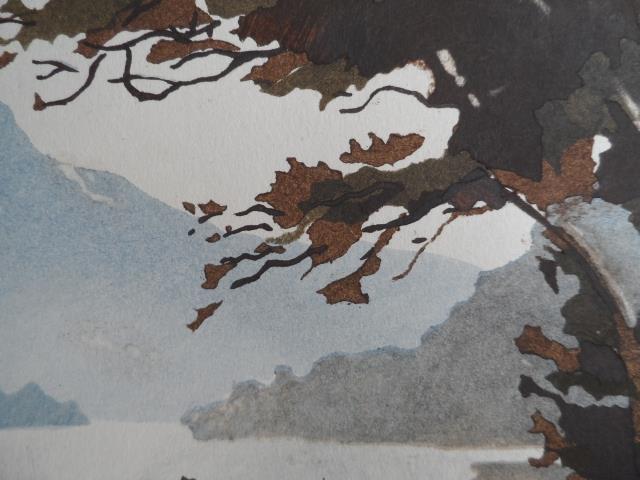
Example of a woodcut
Other Artwork Terminology
In auctions and on our own website you will find common terms used to describe an individual piece
A work described by us with the forename(s) and surname or recognised designation of an artist is, in our opinion, or as advised to us in best faith, a work by that artist
“Manner of “ a work we have judged to be in the mentioned artist's style, but of a later date.
“Attributed to” a piece of the correct timeline and style for the artist, which we believe to be wholly or partially the work of the artist, whether signed or unsigned.
“Circle of” a piece reflecting the correct timeline and style of the artist but we feel should be described as ”showing his influence” rather than more certainly by their own hand.
“Signed/ dated/ inscribed” We believe it has been signed/inscribed/dated by the artist.
“With signature/ date/ inscription” We feel the signature/ date/ inscription are not by the named artist (and may even be of a different date).
“School of” always written with a location/region - indicating that from our research and knowledge the piece described was produced at that time and in that area, showing clear characteristics to regionalise the style and/or subject e.g. Scottish School c 1890.
"Studio of” a piece produced in the studio of the artist, and under at least some part of his/her supervision
“Follower of “ a piece in the correct style of the artist, reflecting closely their work, but not necessarily by a pupil of the artist.
“After” a copy, from any date, of a work by the artist mentioned, or specifically painted to resemble the work of that artist.
In auctions and on our own website you will find common terms used to describe an individual piece
A work described by us with the forename(s) and surname or recognised designation of an artist is, in our opinion, or as advised to us in best faith, a work by that artist
“Manner of “ a work we have judged to be in the mentioned artist's style, but of a later date.
“Attributed to” a piece of the correct timeline and style for the artist, which we believe to be wholly or partially the work of the artist, whether signed or unsigned.
“Circle of” a piece reflecting the correct timeline and style of the artist but we feel should be described as ”showing his influence” rather than more certainly by their own hand.
“Signed/ dated/ inscribed” We believe it has been signed/inscribed/dated by the artist.
“With signature/ date/ inscription” We feel the signature/ date/ inscription are not by the named artist (and may even be of a different date).
“School of” always written with a location/region - indicating that from our research and knowledge the piece described was produced at that time and in that area, showing clear characteristics to regionalise the style and/or subject e.g. Scottish School c 1890.
"Studio of” a piece produced in the studio of the artist, and under at least some part of his/her supervision
“Follower of “ a piece in the correct style of the artist, reflecting closely their work, but not necessarily by a pupil of the artist.
“After” a copy, from any date, of a work by the artist mentioned, or specifically painted to resemble the work of that artist.
MastheadArt.co.uk is a brand and trading style owned and operated by DealDrivers Ltd, registered office
(not open to public) :
10 Abbenesse, Chalford Hill, Stroud, Gloucestershire GL6 8QR
Tel 01453 884601 Mon-Fri office hours
Company number 5302696
All copyright of images used on this website belongs to the originator of the piece and/or MastheadArt.co.uk/DealDrivers Ltd as the current owner of the piece. No use may be made without obtaining prior permission from ourselves of any image on this website
Devon art, cornwall art, cornish art, paintings, original art, british art, english school, robin hoods bay, whitby, whitstable, brighton art, dorset, hampshire, wales, welsh, scottish art, isle of man, isle of wight original art, marine art, coastal art, art for sale British art, maritime art, plymouth, salcombe, dartmouth, Salcombe, Liverpool, Chatham, Greenwich, Poole, Portsmouth
(not open to public) :
10 Abbenesse, Chalford Hill, Stroud, Gloucestershire GL6 8QR
Tel 01453 884601 Mon-Fri office hours
Company number 5302696
All copyright of images used on this website belongs to the originator of the piece and/or MastheadArt.co.uk/DealDrivers Ltd as the current owner of the piece. No use may be made without obtaining prior permission from ourselves of any image on this website
Devon art, cornwall art, cornish art, paintings, original art, british art, english school, robin hoods bay, whitby, whitstable, brighton art, dorset, hampshire, wales, welsh, scottish art, isle of man, isle of wight original art, marine art, coastal art, art for sale British art, maritime art, plymouth, salcombe, dartmouth, Salcombe, Liverpool, Chatham, Greenwich, Poole, Portsmouth
email: enquiry@mastheadart.co.uk

